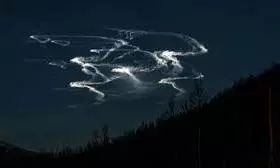
NASA creates artificial clouds beneath northern lights for atmospheric research
text_fieldsIn an extraordinary display on November 10, NASA launched rockets over northern Norway, creating artificial clouds beneath auroras during a minor geomagnetic storm.
The event unfolded near the Andøya Space Center, located close to the Arctic Circle, a prime spot for studying geomagnetic phenomena.
Local tour operator Ivar Sandland, traveling from Bodo to Tromso, witnessed the stunning spectacle. Initially mistaking the unusual streaks for clouds, Sandland later discovered they were part of NASA's experimental research.
The experiment was part of NASA's Vorticity Experiment (VortEx), designed to study energy flow in the turbopause, a transitional region between the mesosphere and thermosphere at around 90 kilometers above Earth.
The rockets released a chemical called trimethyl aluminium, which reacts in the atmosphere to create glowing trails. These artificial clouds help scientists track gravity waves and analyze their interactions at this altitude. The use of sounding rockets - compact suborbital vehicles intended for research - enabled precise data collection while offering onlookers a captivating view.
Andøya Space Center's strategic location near the poles makes it an ideal base for studying auroras and atmospheric phenomena. Charged solar particles interacting with Earth's magnetic field and upper atmospheric gases produce the northern lights, making the region a natural laboratory for such experiments.











